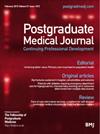Identification of key immune-related genes and potential therapeutic targets in immune checkpoint inhibitor-associated myocarditis.
IF 3.6
4区 医学
Q1 MEDICINE, GENERAL & INTERNAL
引用次数: 0
Abstract
BACKGROUND Immune checkpoint inhibitors (ICIs) are widely used in cancer treatment; however, the emergence of ICI-associated myocarditis (ICI-MC) presents a severe and potentially fatal complication with poorly understood pathophysiological mechanisms. This study aimed to identify crucial immune-related genes in ICI-MC and uncover potential therapeutic targets using bioinformatics. METHODS Using the GSE180045 dataset, which includes three groups-Group A: ICI patients without immune adverse events, Group B: ICI patients with non-myocarditis immune adverse events, and Group C: ICI patients with myocarditis-we analyzed differentially expressed genes (DEGs) between ICI-MC samples (Group C) and non-myocarditis controls (Groups A and B). These DEGs were then cross-referenced with 1796 immune-related genes from the immPort database to identify immune-related DEGs. We conducted functional enrichment analyses (Gene Ontology, Kyoto Encyclopedia of Genes and Genomes, gene set enrichment analysis), constructed a protein-protein interaction network, and identified hub genes. Validation using the GSE4172 dataset led to the identification of optimal feature genes from the overlap between hub genes and DEGs. Predictions of target MicroRNAs (miRNAs) were made, and a competing endogenous RNA (ceRNA) network was constructed. Target drugs for hub genes were predicted using the Connectivity Map database. RESULTS We identified 58 DEGs between ICI-MC and controls, which led to the identification of 32 immune-related DEGs after intersection with 1796 immune-related genes. Functional analyses revealed enrichment in cell lysis, CD8+ T-cell receptor, natural killer cell-mediated cytotoxicity, and RAGE signaling. Notably upregulated hub genes included IL7R, PRF1, GNLY, CD3G, NKG7, GZMH, GZMB, KLRB1, KLRK1, and CD247. In the validation dataset, 407 DEGs were uncovered, resulting in the identification of 3 optimal feature genes (KLRB1, NKG7, GZMH). The predicted target miRNAs, lincRNAs, and circRNAs constituted a comprehensive ceRNA network. Among the top 10 drugs with elevated connectivity scores was acetohydroxamic acid, indicating a need for caution in ICI treatment. CONCLUSION KG7, GZMH, and KLRB1 were identified as pivotal immune-related genes in ICI-MC. Biological enrichments included pathways involved in cell lysis, the CD8+ T-cell receptor pathway, natural killer cell-mediated cytotoxicity, RAGE signaling, and proinflammatory responses. The ceRNA network illuminated the role of critical molecules and underscored the importance of avoiding drugs such as acetohydroxamic acid in ICI treatment. Key message What is already known on this topic Myocarditis is recognized as a serious ICI-associated toxicity, seemingly infrequent yet often fulminant and lethal. The underlying mechanisms of ICI-associated myocarditis remain not fully understood. Although the significance of T cells and cytotoxic T lymphocyte-associated protein 4 (CTLA-4) is evident, the inciting antigens, the reasons for their recognition, and the mechanisms causing cardiac cell injury are not well characterized. An improved understanding of ICI-associated myocarditis will provide insights into the equilibrium between the immune and cardiovascular systems. What this study adds Our study further validates the significance of T cells and CTLA-4 in ICI-associated myocarditis. More importantly, we identified three genes-NKG7, GZMH, and KLRB1-essential for the development of ICI-MC and proposed ceRNA networks involving these three key genes. How this study might affect research, practice or policy The newly discovered key genes and their intricate molecular interactions offer a comprehensive perspective on the mechanisms underlying ICI-MC. Furthermore, our findings advise caution regarding the use of drugs like acetohydroxamic acid during ICI treatment. As our understanding of these regulatory networks deepens, our study provides valuable insights that could inform future therapeutic strategies for ICI-MC.鉴定免疫检查点抑制剂相关心肌炎中的关键免疫相关基因和潜在治疗靶点。
背景免疫检查点抑制剂(ICIs)被广泛用于癌症治疗;然而,ICI相关性心肌炎(ICI-MC)是一种严重且可能致命的并发症,其病理生理机制尚不清楚。本研究旨在确定 ICI-MC 中关键的免疫相关基因,并利用生物信息学发现潜在的治疗靶点。方法利用 GSE180045 数据集,其中包括三组--A 组:无免疫不良事件的 ICI 患者;B 组:有非心肌炎免疫不良事件的 ICI 患者;C 组:有心肌炎的 ICI 患者--分析 ICI-MC 样本(C 组)与非心肌炎对照组(A 组和 B 组)之间的差异表达基因(DEGs)。然后将这些 DEG 与 immPort 数据库中的 1796 个免疫相关基因进行交叉比对,以确定免疫相关 DEG。我们进行了功能富集分析(基因本体论、京都基因和基因组百科全书、基因组富集分析),构建了蛋白质-蛋白质相互作用网络,并确定了枢纽基因。通过使用 GSE4172 数据集进行验证,从中心基因和 DEGs 的重叠中确定了最佳特征基因。预测了目标微RNA(miRNA),并构建了竞争内源性RNA(ceRNA)网络。结果我们在 ICI-MC 和对照组之间发现了 58 个 DEGs,在与 1796 个免疫相关基因交叉后发现了 32 个免疫相关 DEGs。功能分析显示,细胞裂解、CD8+ T细胞受体、自然杀伤细胞介导的细胞毒性和RAGE信号转导等方面的基因富集。显著上调的中枢基因包括 IL7R、PRF1、GNLY、CD3G、NKG7、GZMH、GZMB、KLRB1、KLRK1 和 CD247。在验证数据集中,发现了 407 个 DEGs,从而确定了 3 个最佳特征基因(KLRB1、NKG7 和 GZMH)。预测的目标 miRNA、lincRNA 和 circRNA 构成了一个全面的 ceRNA 网络。在连通性得分较高的前 10 种药物中,乙酰羟肟酸的连通性得分较高,这表明在 ICI 治疗中需要谨慎。生物富集包括参与细胞裂解的通路、CD8+ T细胞受体通路、自然杀伤细胞介导的细胞毒性、RAGE信号转导和促炎反应。ceRNA 网络阐明了关键分子的作用,并强调了在 ICI 治疗中避免使用乙酰羟肟酸等药物的重要性。关键信息 本课题的已知信息 心肌炎被认为是一种严重的 ICI 相关毒性,看似并不常见,但往往是致命的急性心肌炎。ICI 相关性心肌炎的基本机制仍未完全明了。虽然 T 细胞和细胞毒性 T 淋巴细胞相关蛋白 4(CTLA-4)的重要性显而易见,但诱发抗原、其识别原因以及导致心肌细胞损伤的机制还不十分明确。加深对 ICI 相关性心肌炎的理解将有助于深入了解免疫系统与心血管系统之间的平衡关系。我们的研究进一步验证了 T 细胞和 CTLA-4 在 ICI 相关性心肌炎中的重要性。更重要的是,我们发现了三个对 ICI-MC 发展至关重要的基因--NKG7、GZMH 和 KLRB1,并提出了涉及这三个关键基因的 ceRNA 网络。本研究可能对研究、实践或政策产生的影响 新发现的关键基因及其错综复杂的分子相互作用为研究 ICI-MC 的内在机制提供了一个全面的视角。此外,我们的研究结果还建议在 ICI 治疗期间谨慎使用乙酰羟肟酸等药物。随着我们对这些调控网络认识的加深,我们的研究提供了有价值的见解,可为 ICI-MC 的未来治疗策略提供参考。
本文章由计算机程序翻译,如有差异,请以英文原文为准。
求助全文
约1分钟内获得全文
求助全文
来源期刊

Postgraduate Medical Journal
医学-医学:内科
CiteScore
8.50
自引率
2.00%
发文量
131
审稿时长
2.5 months
期刊介绍:
Postgraduate Medical Journal is a peer reviewed journal published on behalf of the Fellowship of Postgraduate Medicine. The journal aims to support junior doctors and their teachers and contribute to the continuing professional development of all doctors by publishing papers on a wide range of topics relevant to the practicing clinician and teacher. Papers published in PMJ include those that focus on core competencies; that describe current practice and new developments in all branches of medicine; that describe relevance and impact of translational research on clinical practice; that provide background relevant to examinations; and papers on medical education and medical education research. PMJ supports CPD by providing the opportunity for doctors to publish many types of articles including original clinical research; reviews; quality improvement reports; editorials, and correspondence on clinical matters.
 求助内容:
求助内容: 应助结果提醒方式:
应助结果提醒方式:


